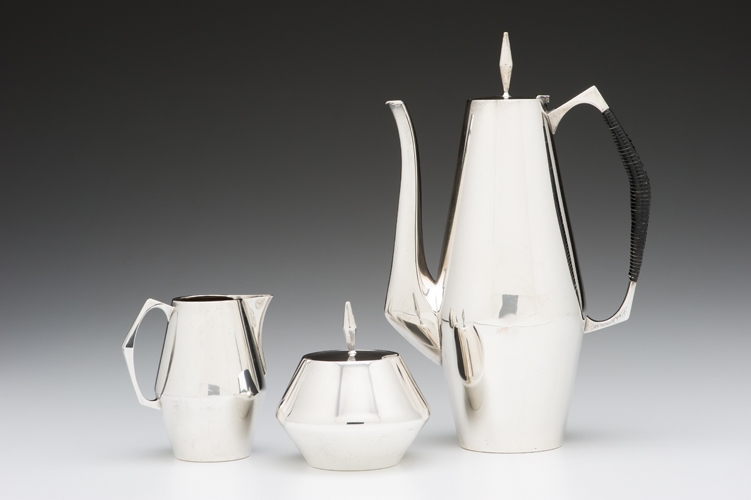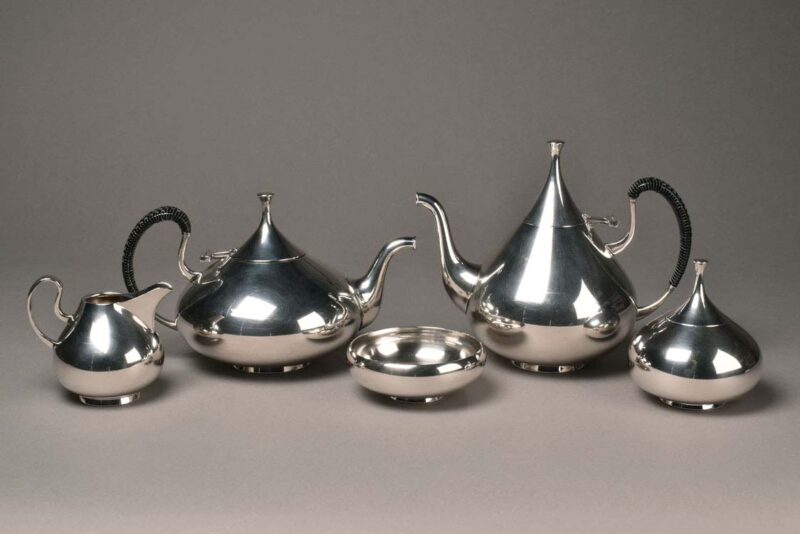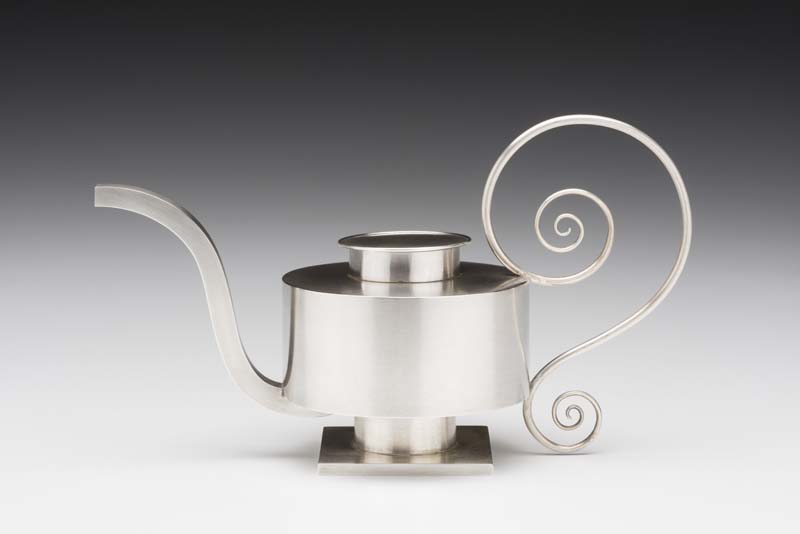“…John Prip has set the standards of excellence in American metalsmithing…As an artist, he has stretched the horizons of the field. As a teacher, he has shared the results of his experiments and encouraged the development of a new – and highly accomplished – generation of metalsmiths. As a designer, he has provided a model for the relationship possible between the artist/craftsman and industry…”[i] – Paul J. Smith, Director Emeritus, American Craft Museum[ii]
The Kamm Teapot Foundation is fortunate enough to have multiple examples of John Prip’s work in its collection. These exquisite silver pieces, which illustrate his skill and expertise, are just a sample of his contributions to the field of metalsmithing. In this blog post we will share these examples with you as well as some information about Prip’s life as an artist.
Early Life and Training
Prip, who was born in New York in 1922, was a fourth-generation silversmith. His Danish father had come to the United States to work in the silver industry. Ultimately, he established a business in Manhattan that produced extravagant platinum and diamond jewelry.[iii] However, after the stock market crashed in 1929, the business suffered. In search of economic stability, the Prips boarded a ship for Copenhagen in 1933. In Denmark Prip’s father went back to work at his family’s silversmithing factory which specialized in flatware and souvenir spoons.[iv]
When Prip turned fifteen, his parents determined that it was time he began an apprenticeship. After attempting to arrange a placement at Georg Jensen’s firm, he ended up at the “highly regarded shop” of Evald Nielsen.[v] Nielsen’s shop, which was smaller in size, proved to be a beneficial situation for Prip. He received greater attention, encouragement, and the opportunity to explore a variety of techniques. Typically, apprenticeships lasted five years. They began with remedial tasks such as sweeping floors and polishing stakes and eventually, this led to an agreement in which pupils were taught the “the trade, the skills, and the art of the silversmith.”[vi] At Nielsen’s shop, Prip started by observing at the workbench, but he was soon given the opportunity to work in metal. The first object he made as an apprentice was a small brass bowl. For his final project he designed a fluted coffee service.[vii] Prip’s early works, such as this coffee service, primarily reflected the Scandinavian modern style popular in Denmark at that time.
School of American Craftsmen and Shop One
Following World War II, Prip returned to the United States.[viii] He had received an invitation to teach at the School of American Craftsmen (SAC) in Alfred, New York. This was a new school and was one of the first to devote special attention to metalwork.[ix] For Prip, SAC provided a “refreshing change” and freedom, but it was also challenging.[x] He was faced with “bringing the formal technical tradition of Denmark into harmony with the American desire for innovation.”[xi] Prip has described these early days of teaching as a “sort of exchange.”[xii] “[He] gave them technical information in exchange for…ideas and environment.”[xiii] Prip says “I came as a teacher, but I was also a student, in a way. I was still young enough.”[xiv] In 1950 when the School of American Craftsmen moved to the Rochester Institute of Technology (RIT) Prip and his family decided to move with the school.
In 1953, after relocating to Rochester, New York, Prip established a gallery called Shop One with fellow artists such as Frans Wildenhain, Tage Frid, and Ronald Pearson. Shop One was distinctive and influential. The gallery, which was operated by artists, was one of the first of its kind in the United States and served as a “forum for the presentation of top-quality avant-garde craftwork.”[xv] Also, “what distinguished Shop One from its successors was its sense of purpose. There was, beyond the hope for a viable income, a feeling of mission; a desire to educate the public to the special beauty of handmade objects.”[xvi] Shop One became even more important in Prip’s life in 1954 when he left his teaching position at RIT. For the next several years he designed and made jewelry in collaboration with Ronald Pearson. These works were sold with the Prip-Pearson mark in their gallery.[xvii]
Reed & Barton
After a few years of “really having to scramble to make ends meet,” Prip was offered a position at Reed & Barton, a hollowware and flatware manufacturer located in Taunton, Massachusetts.[xviii] This opportunity provided a certain amount of freedom. As Prip created drawings, models, and prototypes, he did not need to worry about patrons or the cost of supplies. Prip was given the title Craftsman-in-Residence as well as a workspace, materials, and access to Reed & Barton’s massive factory. He had grown up with “one foot in a factory, so to speak” and understood that Reed & Barton hoped that their arrangement would help turn a profit.[xix] During Prip’s three years working full-time at the company he developed a successful range of fresh modern designs.[xx] In addition, and probably most importantly, this liaison “affirm[ed] the symbiotic possibilities between the worlds of craft and industry.”[xxi]

Kamm Collection
One of Prip’s successful projects for Reed & Barton was launched in 1958. Part of a pattern called Diamond, these vessels contained tapered bodies, angular spouts, rattan-wrapped handles, and smooth highly polished surfaces. The Kamm Collection has two of these sterling silver works: a coffee set and a coffee and tea service. Reed & Barton paired these hollowware forms with flatware by the Italian architect and designer Gio Ponti. For the Diamond line, Prip’s in depth knowledge of metalwork and its construction possibilities proved to be beneficial. He determined that “each vessel could be spun on a separate chuck and then assembled” which was an “ingenious solution for production.”[xxii] Advertisements for these Reed & Barton designs cleverly used the caption “The Diamond is Forever.”[xxiii]
The Kamm Collection also has a silver-plated Reed & Barton tea and coffee service called Dimension from 1961. Unlike the Diamond pattern, these Prip vessels are exaggerated teardrop forms. In this instance, he incorporated dramatic curves, conical lids, and looping handles wrapped with black plastic. He approached Dimension in the same manner as his other Reed & Barton designs. Each one reflected “what [Prip] liked.”[xxiv] At Reed & Barton, he “was free to develop a thought or idea.”[xxv] Prip says, “I felt that rather than attempt to make compromises right from the outset, I would rather make it the way I thought it should be, and then [the company and I] could see if it was appealing or had any possibilities.”[xxvi]
In 1960 Prip left Reed & Barton and, after some short-term teaching stints, he settled at the Rhode Island School of Design in Providence (RISD).[xxvii] While teaching at RISD, Prip really began pushing his work in new directions. He moved further away from his Danish modern roots, exploring sculpture as well as a range of materials and techniques.[xxviii] The Kamm Collection has a sterling silver work from this period. Called Experimental Teapot, it was made around 1979.[xxix] This vessel, which “sat on the mantle in [Prip’s] home for many years” has a simple cylindrical body, a thin spiraling wire handle, and a square base. [xxx] It was finished with a light filing and an emery cloth. Prip wanted Experimental Teapot to be “a lyrical, non-fussy counterpoint to the highly polished and refined hollowware designs for which [he] was so well known.”[xxxi] Prip had a natural inclination towards experimentation and did not fear going “outside his comfort zone.” [xxxii] This was particularly evident in the latter portion of his career. Prip had trained as a traditional silversmith, not an artist. However, his exposure to the arts led Prip on a journey, a journey of discovery which has had a lasting impact on the field of metalsmithing and beyond.

Further Reading/Viewing:
Janet Prip. Networks Rhode Island. November 2, 2016.
McCreight, Tim, Paul Smith, and Christopher P. Monkhouse. John Prip: Master Metalsmith. Providence, RI: Rhode Island School of Design Museum of Art, 1987.
Oral History Interview with John Prip. Smithsonian Archives of American Art. 20 October 1980 and 21 November 1981.
Peter Prip. Networks Rhode Island. November 4, 2013.
RIT Archive Collections, John Prip and Shop One.
Stern, Jewel. Modernism in American Silver: 20th Century Design. New Haven, CT: Yale University Press, 2005.
Notes:

